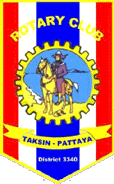- HEADLINES [click on headline to view story]:
-
Cricket: The Chiang Mai Sixes - and the way forward for young players
-
Meet a man with a “cheating heart”
-
Wine King of Spain
-
“Born” to greatness
|
|
Cricket: The Chiang Mai Sixes - and the way forward for young players
story and photos by Peter Cummins
“That’s not cricket,” was one of the dreadful
clich้s thrown at me as a (rather) errant child in Tasmania in the
1940s. It was aimed to accentuate each of the many misdemeanours and
rebellious behaviour which seemed to be my trademark (so, what’s new
today? Peter Malhotra, the Pattaya Mail managing director often
asks me). The ONLY difference is that this tired old phrase has gone out
of vogue.
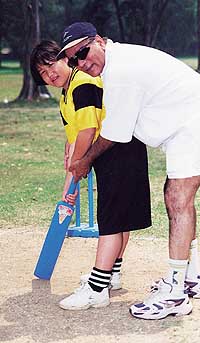 The
coach shows how. The
coach shows how.
What IS in vogue, however, is the opposite. A trend,
gathering much momentum in Thailand - especially among Thai school
children - is the embrace of the royal and ancient game. This IS cricket
is the catch phrase. Read on, to see why.
Pattaya Mail special correspondent Peter Cummins
went to Chiang Mai last April to cover the Chiang Mai Sixes VERY
diligently (of course) for the Eastern Seaboard’s leading English
language newspaper, euphemistically - and correctly - called “The Best
in the East”. Now, he presents a preview of the forthcoming Chiang Mai
International Cricket Sixes and an overview of the state of junior cricket
in the Kingdom.
The Fifteenth Chiang Mai Sixes
Our own Pattaya-based Pectels cricket team will be back
again in April to take part in this year’s Fifteenth Chiang Mai
International Cricket Sixes. There will be some changes in the composition
of this cosmopolitan group and they will compete as the Pectels 59, rather
than the Pectels 69, this year competing for the ‘Spoon’ title.
 Moving
in to bat: the ball is soft but the determination is not! Moving
in to bat: the ball is soft but the determination is not!
Since it started in 1988, the Chiang Mai International
Cricket Sixes has become a most popular event, played out at the
century-old (in cricketing jargon, 104 not out) Chiengmai Gymkhana Club
Cricket Ground and, as the fifteenth approaches this April, the focus is
on the development of cricket in Thailand, especially among Thai children.
According to Chiang Mai-based cricket aficionado, Geoff
Thompson, this year’s tournament, the cricket world’s most popular
amateur competition of its kind, will constitute the biggest event yet.
The six-a-side tournament is scheduled to run for 6 days from April 1 - 6,
2002.
 Sending
down a fast one... Sending
down a fast one...
Over 300 cricketers, friends and family members are
expected to descend on Chiang Mai, with a record 30 teams scheduled to
take part this year. New club teams apply from all over the world, and are
invited to the event each year (6 new teams this year), but the majority
taking part have become regular annual participants. The teams this year
will come from the UK (8), Australia (8), Thailand (7), Malaysia (2), and
Bahrain, China, Dubai, Philippines, and South Africa (1 team apiece).
Running in tandem with the main event, on an adjacent
field, will be the Third Sixes Junior Cup. This competition for local
school teams is part of a successful on-going programme started two years
ago and funded entirely by donations from Chiang Mai Sixes’
participants, to introduce a junior form of cricket into Thai schools.

Happy
youngsters take to cricket: a natural sport for agile Thai children.
Chiang Mai Sixes always attracts guest stars who play
with the club teams and enliven the already active social scene. One such
stalwart, who expects to return again this year, is former England and
Middlesex captain, Mike Gatting. In spite of being “clean-bowled” by a
‘youngster’ during one innings last year - and then spending a night
or two in hospital suffering from some heat exhaustion and dehydration,
Gatting loved it! “This tournament is about making friends, and I’ve
enjoyed myself immensely!” he said after it was all over - heat
prostration or not!
Junior Cricket
The focus, outside of the record 30-plus teams coming
to Chiang Mai, will be on the development of junior cricket which, since
the founding of the Chiang Mai Schools Cricket Alliance (CSMA) over a year
ago with just four teams, has now expanded to 20 schools enthusiastically
embracing local cricket competitions. The only obstacle to more rapid
progress, according to Geoff Thompson, one of the leading supporters of
the CSMA, is the necessary funding for trainers and coaches for the
juniors, a prerequisite also recognized by the Asian Cricket Council (ACC)
and the Thailand Cricket League (TCL).
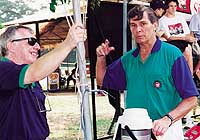 Movers
and shakers (in junior cricket, at least) Geoff Thompson (L) and Maurice
Bromley. Movers
and shakers (in junior cricket, at least) Geoff Thompson (L) and Maurice
Bromley.
Maurice Bromley, a Bangkok-based supporter - and the
driving force behind the annual Chiang Mai Sixes since the inaugural event
in 1988 - feels that “junior cricket is at a very tricky stage”. As
chairman of the Organizing Committee for the Sixes since Day One, Maurice
told the Pattaya Mail last week that, “The Chiang Mai juniors are
going well and constitute an excellent pilot example, but emphasis must be
placed on developing the Bangkok scene, to attract the attention and
support of the ACC.” Further, the hard-driving chairman added, “We
require a well known and respected Thai national to be the figurehead.
There is no question in the minds of anyone associated with this program
that Thais could make excellent cricket players; far better, in fact, than
soccer, basketball or any of the other sports they play.” Sponsors are
desperately needed, Maurice concluded, “to move the programme
forward.”
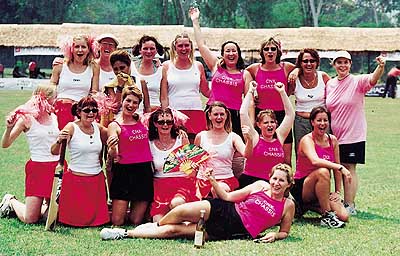
The
“Chassis Lassies”: unbeatable on the field.
Both the ACC and the TCL realized the potential at the
CMSCA’s latest inter-schools tournament. The CMSCA’s focus is on
promoting a junior version of the sport of cricket for youngsters aged
between 9 - 12 years old. It is perhaps the only sporting body, certainly
in Chiang Mai, involving both Thai and International schools. “The
cultural exchange is an important part of the attraction as far as the
school teachers are concerned, but for the Thai children especially,
junior cricket is simply a new game to enjoy, and one they play very
successfully,” said Peter Dawson, the acting chairman of the CMSCA, at
the most recent inter-schools tournament held on Sept 30th at the grounds
of Sai Moon School near the village of Hang Dong in which eight school
teams participated. Observers at the event were development officer for
the ACC and Indian ex-international all-rounder Roger Binny, as well as
Ravinder Ghai, the TCL’s own development officer. The two were joined by
committee members of the CMSCA, including Thai health and welfare activist
Somboon Suprasert, an enthusiastic promoter of the Alliance’s aims who
has introduced several schools to the CMSCA.
Following this third successful inter-schools
tournament organised by the CMSCA, Peter Dawson explained how the Alliance
is promoting junior cricket among Thai schools. “All the schools where
we introduce junior cricket, we receive the necessary equipment - bats,
stumps and balls - plus the coaching, of course, sponsored by the CMSCA.
This is not a very expensive operation - the rubber balls (although old
tennis balls will do at a pinch) are probably the most expensive item
because they come from Australia and cost 120 baht each.”
The CMSCA, meanwhile, announced that its next
inter-schools junior cricket tournament for Grades 5/6 children will be
held on January 27th 2002, at Prince Royal College.
Coaching and sponsorship: the way forward
“It is wonderful to see how naturally so many Thai
schoolchildren take to the game of cricket. We seem to have the formula
right too, but our real limitation is coaching manpower. We could cover
lots more schools, the demand is there, but at the moment we are 80%
dependent for coaching on just one volunteer. Eric Little, a retired
Australian resident of Chiang Mai,” said Peter. “We are reticent of
taking on more schools for this reason, but this is less as a problem, and
more of an opportunity for the future of cricket in Thailand,” added
Peter, emphasizing that, “The answer lies in the appointment of a
professional coach.
 UNICEF
Youth Envoy, Khataleeya McIntosh awards a medal to a junior – and
budding – cricketer. UNICEF
Youth Envoy, Khataleeya McIntosh awards a medal to a junior – and
budding – cricketer.
“History has shown that cricket is a sport well
suited to hot climates, perhaps even better suited than soccer,” Peter
pointed out. “Just look at India, Pakistan, Australia and the West
Indies and think about their records in cricket vs. football! In Chiang
Mai we have seen that the demand and the talent for cricket are there in
Thai schools. The CMSCA has proved in a small way that a viable programme
to introduce and foster cricket at a junior level in Thai schools is not
difficult or particularly expensive to achieve,” he added.
Peter recognises that starting this has probably been
easier in a smaller area like Chiang Mai, and agrees with Maurice that,
“We need Bangkok. It will never become an accepted Thai sport without
eventual leadership from Bangkok. And we need a professional cricket coach
for Thailand with full time commitment to leading the development of the
sport here and training other part-time or volunteer coaches.”
This is not entirely a pipe dream of Peter Dawson and
Maurice Bromley. Bangkok has taken its own cricket development steps at
the junior level, albeit mostly among international and Thai-Indian school
children up til now. In fact, Brian Wiggins, a successful Australian
Cricket Board (ACB) registered professional coach already has a close
knowledge of, and association with Thailand. Brian has coached
schoolchildren in Bangkok and Chiang Mai on a short term secondment with
the TCL in 1999-2000.
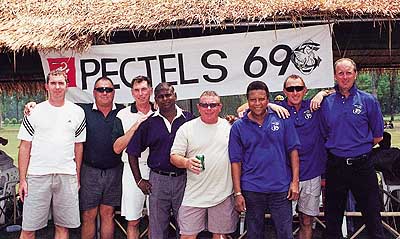
The
“Pattaya Pectels 69”, this year will be the “Pattaya Pectels 59”,
striving for the Spoon Title.
However, he lacks a full-time appointment to carry on
the work he began so successfully and, again, “Funding is the key,”
repeats Peter. “We have heard keen interest expressed by several bodies,
including the United Nations Children’s Fund (UNICEF), the International
Cricket Council, the Asian Cricket Council, and even the Australian
Cricket Board. We have even had one or two commercial sponsorship
enquiries. But to-date no one has made the all-important financial
commitment. We have a successful programme outline, we have the demand, we
even have the proven coaching leadership waiting in the wings,” Peter
enthuses.
“If these or any organizations truly wish to see
cricket develop in Thailand, now is the time to come forward with
financial support,” he pleads. Eric Little and Brian Wiggins, with help
from the schools themselves and some inspired volunteer interpreters and
artists, have translated the complete rules of junior cricket, with
graphics, into the Thai language. It includes drawings of how to bowl and
bat, and has cricket phrases (in English, I assume, for I do not possibly
see how the immortal cricket phrase term “HOWZAT” could be translated
- into ANY language!). The booklet, once again, dependent on sponsorship,
will be distributed to every child who starts cricket.
The CMSCA have had quantities of bats and other
equipment made cheaply in Thailand to give to the schools. At this point,
over 1,000 Thai school children have been introduced to junior cricket and
the CMSCA believes that the potential is enormous.
Given active commercial sponsorship and a qualified
coach to lead the process, we estimate that over a million Thai children
could be enjoying the game of junior cricket within a year. Certainly, it
seems likely that with a programme to introduce junior cricket
nation-wide, the Asian Cricket Council and cricket’s governing body the
ICC would finally be prevailed upon to look at Thailand as a developing
cricketing country and all those involved with junior cricket believe that
Thailand could play internationally as a national team within 10 years if
the opportunity is seized now. Peter Dawson has the last word, “In
Australia and New Zealand, international companies sponsor the junior
cricket programme, so why not in Thailand, where the potential is even
bigger?”
Updated information about the Chiang Mai Sixes and
junior programmes can be accessed online at: www.chiangmaicricket.com
For more information (media enquiries) and interest in
any sponsorship, please contact:
Geoff Thompson
Chiang Mai Sixes Organizing Committee 244 Chiang Mai-Praw
Road, Ampur Sansai, Chiang Mai 50210, Thailand Email: [email protected]
Sponsorship enquiries can also be directed to Maurice
Bromley, tel. (66 2) 229-4747-8; fax (66 2) 229-4749; e-mail [email protected]
Meet a man with a “cheating heart”
Ripley’s Believe It or Not! Museum Pattaya is
inviting everyone to meet the one and only Ekapong Pheepakpror and see his
heart throbbing.
 Ekapong
Pheepakpror, who really wears his heart on his chest. Ekapong
Pheepakpror, who really wears his heart on his chest.
Ekapong, also known as ‘Nong Day’ was born 15 years
ago on December 27th in the province of Tak. He was born with 32 organs
and they were all in the right places - except for his heart. It is
situated outside his ribcage. To be exact, it is beating just underneath
his outer skin below the ribcage, where you can actually see and feel the
beats of his heart. As the result of this abnormality, Ekapong is
diagnosed as having ‘valvular heart disease’ since birth.
The first 6 years of his life, his mother Pensri sent
her son to Suan Dok Hospital in Chiang Mai periodically, hoping an
operation could improve his condition. Unfortunately nothing could be
done. When assured that his health was stabilized Pensri brought him back
and raised him in her hometown in Tak. Fearing that other children or
school activities would endanger his life, she didn’t allow her son to
attend school. Despite his heart condition, Ekapong led a happy and normal
life. His favorite sport is table tennis and he loves to ride a motorbike
whenever he has a chance.
From now until February 3 you can come to Ripley’s
Believe It or Not! Museum on the 3rd floor of the Royal Garden Plaza and
meet Ekapong in person. See how your own heart functions by observing his.
You won’t believe your eyes!
Wine King of Spain
It’s been over 30 years since the Torres family broke
the mould of Spanish (and one could say Mediterranean) winemaking with the
magnificent 1970 Gran Coronas Cabernet. Until then the only Spanish wines
of quality had been in the Rioja mould. Up to then Pened่s had meant
only cava (Spanish sparkling wine). Now here was a great “claret” with
a Catalan stamp never tasted before. The man behind this revolution was
none other than Miguel A. Torres, one of the true superstars in the world
of wine.
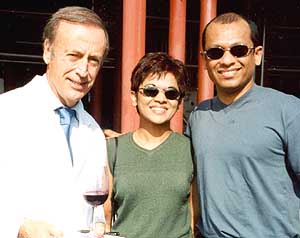 Ranjith
and his wife Chitra Chandrasiri with the wine king of Spain, Miguel A.
Torres during their recent wine expedition in Spain. Ranjith
and his wife Chitra Chandrasiri with the wine king of Spain, Miguel A.
Torres during their recent wine expedition in Spain.
The family winery of Miguel Torres has been at the
forefront of the Spanish wine revolution for centuries. The wine-growing
history of the Pened่s goes back to the remote days of the first
European cultures. The Torres family has been cultivating its own
vineyards in the Pened่s ever since the 17th century.
It was in the first half of this century that Miguel
Torres Carb๓ (father of Miguel A. Torres) finally launched the wines
and brandies on an international scale. Overcoming the crises of the
Spanish Civil War and World War II, with intelligent and inspired
perseverance he expanded his vineyards, excavated new underground ageing
facilities, modernized the winery and production techniques and - with the
help of his wife Margarita - laid the foundations for a great exporting
enterprise. Since 1870 the house of TORRES has been passing down the
secrets of making great wines, from father to son, as a jealously guarded
heritage and a family tradition.
Miguel A. Torres, the current president of the Torres
wine empire, was born in 1941. Determined to carry on the family tradition
and to make the best Spanish wines, young Miguel studied Chemistry at the
Barcelona University and then Oenology and Viticulture at the University
of Dijon. Armed with a Masters Degree, he returned to the family business
in 1966 and began to plant non-traditional grapes such as Cabernet
Sauvignon and Chardonnay in the family’s vineyards in Catalonia.
While Torres wasn’t the first to plant
“international” grape varieties in Spain, it was undoubtedly his
success with these varieties - particularly his Gran Coronas 1970
Cabernet, which outscore the mighty Chateau Latour and won the
Gault-Millau Wine Olympiad in France in 1979 - that brought the new wave
of Spanish wines and winemakers to the world’s attention.
Since the 1980s, though, Torres has been rediscovering,
recuperating and propagating indigenous Catalan grape varieties like
garnacha (genache), monastrell (mourvedre), and more obscure varieties
such as garro and samso. The culmination of that work is Torres’ newest
wine, Grans Muralles, named after the 14th century wall that sits in the
vineyard from which it hails.
During a recent wine tour in Spain, my wife and I were
privileged to visit the Torres wine kingdom as special guests of the
Torres family. It was truly an unforgettable cultural and gastronomic
experience complete with a visit to the Torres wine museum, historical
15th century Milmanda castle and Grans Murralas vineyards, extensive wine
tasting at the Mas Rabell de Fontenac estate, visits to the wineries and
cellars. Endless fiestas on delicious Spanish food (washed down with
Torres wines) were sympathetically fit into our week-long expedition
including scrumptious luncheons at the Torres private restaurant,
enchanting Milmanda castle, elaborate and long (until dawn) dinners at the
Mas Granell in Moja, famous Seven Portes Restaurant in Barcelona and an
extravagant degustation dinner at the beautiful Talaia Restaurant
overlooking Barcelona Harbour. We left with fond memories of Catalan
hospitality and a special affection for the fine Spanish food, wine and
salsa.
We dined at the Torres private restaurant in the
cordial company of Miguel Torres Jr, who himself has made a name for his
own label, Jean Leon wines, named after the famous Spanish restaurateur of
the 60s. Lunch, which was deliciously prepared by Gareth York, Michelin
Star Chef of the Torres private restaurant, included Ensalada de Verduras
complimented by exquisitely fruity and intensely aromatic Gran Vina Sol
2000, Estofado de con Patatas y Albondigas served with Marimar Torres
Estate Chardonnay 1999 (excellent) followed by Quesos Catalanes matched
with Gran Coronas 1997 - a delightful blend of Cabernet and Tempranillo.
Typical Catalan dessert Crema Catalana was served with Moscatel Oro
followed by famous Torres 10 and Torres 20 brandies to finish off the
fiesta.
At the Pac del Penedes bottling plant and cellars, we
were greeted by Miguel A Torres, the wine king of Spain, accompanied by
his daughter, Mireya who is also an accomplished wine maker. Miguel spoke
enthusiastically about his craft and his passion for the vine. “To me
the highlight of the day is when I go to the vineyards. The secret of
making great wines is in the “pagos”, harmonious matching of the best
grape varieties with the right soil and the climate”.
From the very beginning, Bodegas Torres have taken
great care over the selection and acquisition of some of the finest
“pagos” - single vineyards. Today, 1600 hectares of vineyards have
been acquired in Spain as well as in the best wine regions in the world.
In 1979 Miguel Torres Carbo acquired a small winery in Curico, Chile
pioneering the investment in this viticulture paradise by the foreign
companies. Don Miguel Vineyard in California was acquired by Marimar
Torres, a sibling of Miguel and in 1986, began planting Chardonnay, Pinot
Noir and Parelada, a white variety native to Catalonia. Torres vineyards,
whether in Chile, California or Catalonia, are cultivated using the most
advanced and stringent viticulture techniques, with respect for the
environment as a top priority.
History has left its indelible traces on the landscape
of Torres vineyards. A visit to Torres estates and properties in Catalonia
also offers splendid opportunities to view medieval castles and monastery
farms like Milmanda, ancient royal hunting fields like Mas La Plana, and
mysterious retreats of Moorish alchemists like the old marabout of Mas
Rabell, and the beauty of the Conca de Barbera countryside.
Bodegas Torres’ ageing cellars extend over two
kilometers of underground galleries, excavated on different levels. Here
lie the oak barrels in which the wines mature. Miguel Torres places great
emphasis on the selection of the correct wood for the ageing of each of
his wines, according to style, grape variety and vintage, selecting the
best new wood from a variety of American and European forests: Ohio, Tron็ais,
Nevers, Allier, Limousin.
In Cava Josefa cellar, which is set aside for the
ageing of red wines, more than six thousand barrels are stacked. In Cava
Margarita there are another five thousand barrels for the ageing of red
and white wines.
A special building is used for the ageing of Milmanda,
a Chardonnay wine fermented in small oak casks which spends a long period
in contact with its own lees. The other ‘reserva’ wines spend time in
various different underground galleries, which are laid out according to
their respective ‘rackings’ (from new barrels to two or three-year-old
barrels).
Underground cellars, where oak and time work their
inimitable magic to round off and enrich the wines, the slowness of the
process, the silence, the intriguing aromas of the wines as they mature in
their oak barrels, give the cellars something of a shrine-like atmosphere.
The outcome of this long tradition, backed up by the
endless passion for creativity, is the comprehensive and varied range of
Torres wines. Throughout history, creating each and every Torres wine
whether white, rose, red, young or aged has marked the perfection of a
unique style.
Fruity and crispy 1999 Coronas white is an ideal
companion for the Spanish tapas and Mediterranean food. For reds, try the
delightful Sangre de Toro, which is a blend of Spanish grapes Garnacha and
Carinena with exuberant notes of spices and blackberries or the Coronas
which is a blend of great Spanish grape Tempranillo with a touch of
Cabernet - a delicate balance between wild berries, liquorice with spicy
hints of oak and smooth fruit tannins.
Then come the blockbusters, Torres’s renowned single
vineyard Cabernet Sauvignon Mas la Plana - a distinctively powerful red
wine; rich blackcurrant wrapped in smooth velvety oak, an explosion of
fruity flavours in the palate is so characteristic of a top quality
Spanish red. Miguel’s latest creation, the extraordinary Grans Murallas
made from a single vineyard and only the native Spanish grapes garnacha
(Grenache), monastrell (mourvedre) samso (cinsault) garro and carinena, is
deep, sensational and uniquely Spanish!
Good news is that most of the Torres wines are
affordable and a good selection is available in Thailand. The next time
you want to add a little Spanish touch to your dinner table, why not try a
Torres?
Ranjith Chandrasiri is the resident manager, Royal
Cliff Grand, Royal Cliff Beach Resort, Pattaya, Thailand, email: ranjith @royalcliff.com
or [email protected]
“Born” to greatness
by Dr. Iain Corness
Once a year, the vice chancellor of the Asian
University of Science and Technology, Dr. Viphandh Roengpithya invites a
notable man of science to address his university. This year it was
Professor Gustav Born, a man whose family background was to steer him
inexorably towards the hallowed halls of academia. After all, how many of
us have fathers who have been awarded the Nobel Prize? Professor Gustav
Born’s father, Professor Max Born, was awarded the Nobel Prize for
Physics in 1954. Not only that, but Professor Max had nine Nobel Prize
winners between his staff, students and associates.
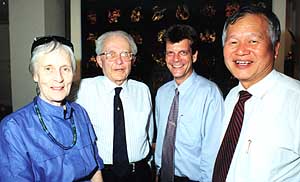 (L
- R) Dr. Faith Born, Professor Gustav Born, Michael Vogt, and Dr. Viphandh
Roengpithya. (L
- R) Dr. Faith Born, Professor Gustav Born, Michael Vogt, and Dr. Viphandh
Roengpithya.
Despite a string of credentials which would be hard to
top (see the footnote), Professor Gustav, who was staying at the Amari
Orchid Resort with his wife Dr. Faith Born, came across as a most humble
and approachable man. A director of the William Harvey Research Institute
in London, yet he was happy to discuss all types of subjects with anyone
who would come up to him, even such subjects as the actress Olivia
Newton-John, who it turned out, is his niece.
Now 80 years of age, Professor Gustav Born graduated in
Edinburgh in 1943 and served in the British Army in the medical corps for
some years before branching out into the field of pharmacology, a sphere
of medical endeavour that still holds a fascination for the professor.
I quote from an address given by him to the Royal
Society for Health, where he said, “My own field of research is
arteriosclerosis, the disease which narrows arteries, causing heart
attacks and strokes. Undoubtedly, a major element in the cause is
cholesterol carried by proteins in the blood, which penetrates the artery
walls and narrows them so that blood cannot pass. Humans eat meat and
fats, making very inefficient use of the food chain. Passing agricultural
products through animals and, via them, to us, is a most inefficient way
of utilising the actual land mass, yet we continue to do so, despite
everything that we have learned. By eating principally only fruit and
vegetables, we would not only avoid heart attacks, but also make more
efficient use of the food-production system.” All very true.
He uses words like, “Splendid, Exciting, Wonderful”
all spoken with enthusiasm, as he warms to any subject of discussion. “I
have an interest in all things,” he said, and indeed he does,
investigating and probing with a true analytical mind. He is also a
humanitarian, working all his life for the good of mankind, albeit from
the scientific research point of view.
Again I quote from his address to the Royal Society of
Health, where he comments, “Capital should not be expended, at present,
on extensive technologies, even such as space travel. Much broader
investigation of their consequences is required, which is, once again,
where education comes in. My father said that space travel was a triumph
of the intellect, but a tragic failure of reason, and added that intellect
distinguishes between the possible and the impossible, whereas reason
distinguishes between the sensible and senseless. However interesting it
was to put men on the moon, it was a huge distraction from what ought to
be done for the people on earth.” Once again, the application of cold
logic to a world need, and how correct.
It was an interesting afternoon in the company of such
a man, and Dr. Viphandh is to be congratulated for bringing someone of
this calibre to this country for an academic address. Professor Gustav
Born is a man you would never tire of listening to his ideas, concepts and
theories. A remarkable man from a remarkable family, his personal
credentials follow.
Professor Gustav Born is Director of the William Harvey
Research Institute, St. Bartholomew’s Hospital Medical College, as well
as, Emeritus Professor of Pharmacology at the University of London. His
previous appointments include Vandervell Professor of Pharmacology, Royal
College of Surgeons of England and University of London; Honorary
Director, Thrombosis Research Group, Medical Research Council; Shield
Professor of Pharmacology, University of Cambridge and Professor of
Pharmacology, Kings College, University of London. Member of the Royal
Society since 1972 and recipient of the Royal Medal in 1987, he is also
Fellow of the Royal College of Physicians; Honorary Fellow, St. Peter’s
College, Oxford; Fellow, King’s College, London; Honorary Doctor of
Science, University of Bordeaux, University of Paris Loyola University
Chicago; Honorary Doctor of Medicine, University of Munster, University of
Leuven, University of Edinburgh, Brown University, University of Munchen;
Honorary Member, Society for Advances in Internal Medicine; Member,
Akademie Leopoldina; Honorary Life Member, New York Academy of Sciences;
Corresponding Member, Belgian Royal Academy of Medicine, German
Pharmacological and Physiological Societies, Societe de Biologie;
President, International Society on Thrombosis and Haemostasis; Foundation
President, British Society for Thrombosis and Haemostasis; Member and/or
Chairman of the Scientific Advisory Boards of many leading pharmaceutical
companies (Merck, Bayer, ICI, Reckitt and Colman) and Honorary Member of
the Club of Rome. In addition, Professor Born has been awarded the Paul
Morawitz Prize, the Robert Pfleger Prize, the Alexander von Humboldt Award
and the Chevalier de l’Ordre National Decoration of Merit.
|
|
|
|
News | Business News | Features | Columns | Letters | Sports | Auto Mania
Kid's Corner | Who’s Who | Travel | Our Community | Dining Out & Entertainment
Social Scene | Classifieds | Community Happenings | Books Music Movies
Club in Pattaya | Sports Round-Up
E-mail: [email protected]
Pattaya Mail Publishing Co., Ltd.
370/7-8 Pattaya Second Road, Pattaya City, Chonburi 20260, Thailand
Tel.66-38 411 240-1, 413 240-1, Fax:66-38 427 596
Copyright © 2002 Pattaya Mail. All rights reserved.
This material may not be published, broadcast, rewritten, or redistributed.
|
|
|

 The
coach shows how.
The
coach shows how. Moving
in to bat: the ball is soft but the determination is not!
Moving
in to bat: the ball is soft but the determination is not! Sending
down a fast one...
Sending
down a fast one...
 Movers
and shakers (in junior cricket, at least) Geoff Thompson (L) and Maurice
Bromley.
Movers
and shakers (in junior cricket, at least) Geoff Thompson (L) and Maurice
Bromley.
 UNICEF
Youth Envoy, Khataleeya McIntosh awards a medal to a junior – and
budding – cricketer.
UNICEF
Youth Envoy, Khataleeya McIntosh awards a medal to a junior – and
budding – cricketer.
 Ekapong
Pheepakpror, who really wears his heart on his chest.
Ekapong
Pheepakpror, who really wears his heart on his chest. Ranjith
and his wife Chitra Chandrasiri with the wine king of Spain, Miguel A.
Torres during their recent wine expedition in Spain.
Ranjith
and his wife Chitra Chandrasiri with the wine king of Spain, Miguel A.
Torres during their recent wine expedition in Spain. (L
- R) Dr. Faith Born, Professor Gustav Born, Michael Vogt, and Dr. Viphandh
Roengpithya.
(L
- R) Dr. Faith Born, Professor Gustav Born, Michael Vogt, and Dr. Viphandh
Roengpithya.

